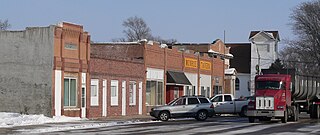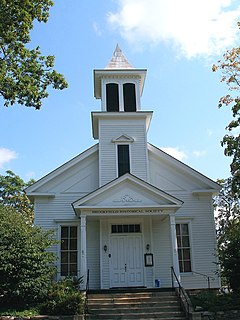
The Brookfield Center Historic District in Brookfield, Connecticut is a historic district that was listed on the National Register of Historic Places in 1991. It is located in the vicinity of the junction of Route 133 and Route 25. The district represents the original settlement of the town of Brookfield and contains 67 residential, religious, and municipal buildings over a 43-acre (17 ha) area representing a wide range of architectural styles from the 18th to 20th centuries including Bungalow/Craftsman, Greek Revival, and Queen Anne style architecture. The district includes the old town hall, the Congregational Church of Brookfield, Saint Joseph Church & Elementary School, Center Elementary School (Public), the former general store, St. Paul's Episcopal Church, and the surrounding residential neighborhood. The district is architecturally significant as an accurate representation of the historical development of the original settlement of the Town of Brookfield as the buildings are well-preserved from the time they were built with minimal alterations and intrusions, including their spatial relationships to one another.

Hale Halawai O Holualoa is the former name of a historic church located in the Kona District on the Big Island of Hawaii.

Andrew Jackson Warner, also known as A. J. Warner, was a prominent architect in Rochester, New York.

United Congregational Church of Irondequoit, also known as Irondequoit United Church of Christ, is a historic Congregational church complex in Rochester in Monroe County, New York. The complex consists of three connected buildings: a Colonial Revival-style church (1926), a Woman's Christian Temperance Union hall (1910), and a church school.
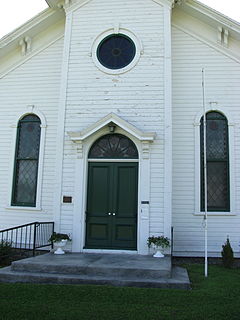
Nelson Welsh Congregational Church is a historic Congregational church located at Nelson, Madison County, New York. It was built in 1876, and is a one-story, three bay by four bay, timber frame structure with a gable roof and stone foundation. It measures 34 feet by 55 feet. It features a three-stage bell tower with octagonal spire. Also on the property are a contributing privy and cemetery. The cemetery contains the graves of Nelson's earliest settlers with the oldest stone dated to 1809.

First Congregational Church and Cemetery is a historic Congregational church and cemetery on US 9 at Elizabethtown-Lewis Road in Lewis, Essex County, New York. It was built between 1823 and 1834 and slightly modified in the late 19th century. It is a rectangular, gable roofed frame building sheathed in clapboard siding. It features a large, central bell tower with an elegant Federal style belfry topped by a bell cast roof. Adjacent to the church is the 7.6-acre (3.1 ha) village cemetery established in the 1820s and still in use today.

Stephen Carpenter Earle was an architect who designed a number of buildings in Massachusetts and Connecticut that were built in the late 19th century, with many in Worcester, Massachusetts. He trained in the office of Calvert Vaux in New York City. He worked for a time in partnership with James E. Fuller, under the firm "Earle & Fuller". In 1891, he formed a partnership with Vermont architect Clellan W. Fisher under the name "Earle & Fisher".

Union Historic District is a national historic district located at Union, Monroe County, West Virginia. The district includes 174 contributing buildings, 2 contributing sites, 7 contributing structures, and 1 contributing object in the Union and surrounding areas. Notable properties include the Monroe County Courthouse, Union High School (1939), Monroe County Confederate Monument (1901), Monroe Department Store (1898), Watchman Office, Union Presbyterian Church (1922), Union United Methodist Church, old Baptist Church, All Saints Episcopal Church, old brick Methodist Church, old Union Academy, Old Temperance Hall, Located in the district are the separately listed Elmwood, Walnut Grove and Brig. Gen. John Echols House.

Monroe Street East Historic District is a national historic district located at Wheeling, Ohio County, West Virginia. The district encompasses six contributing buildings. They are a Greek Revival style church built in 1837, a Roman-Tuscan style dwelling dated to 1852 and known as the Paxton-Reed House, and an eclectic 1881 dwelling. Also in the district is a Richardsonian Romanesque style apartment building and a set of vernacular post-American Civil War townhouses.

Athens Historic District, also known as Tioga Point Historic District, is a national historic district located at Athens, Bradford County, Pennsylvania. The district includes 97 contributing buildings and 1 contributing site in a primarily residential area of Athens. The buildings date between about 1801 and 1935, and include notable examples of vernacular and high style Greek Revival and Queen Anne style architecture. Also located in the district are the First Presbyterian Church (1881), Trinity Episcopal Church (1860-1861), and Riverside Cemetery / Old Athens Cemetery. Located in the district and separately listed are the Protection of the Flag Monument and Spalding Memorial Library-Tioga Point Museum.

The First Congregational Church is a historic church located at 106 South Bostwick Street in Charlotte, Michigan. It was built in 1872 and added to the National Register of Historic Places in 1993. It continues to serve as a Congregational church.

Lititz Moravian Historic District is a national historic district located at Lititz, Lancaster County, Pennsylvania. The district includes 113 contributing buildings, 1 contributing site, and 2 contributing structures in Lititz. It has notable examples of the Federal and Late Victorian architectural styles. The buildings date from about 1755 to 1930. Notable buildings include the Warden's House, Corpse House (1786), Werner House, Tinsley Cottage, Sisters' House (1758), Moravian Church (1787), Brothers' House (1759), Lititz National Bank, Commonwealth National Bank (1922), Mary Dixon Memorial Chapel (1884) on the campus of Linden Hall School, and General Sutter Inn.
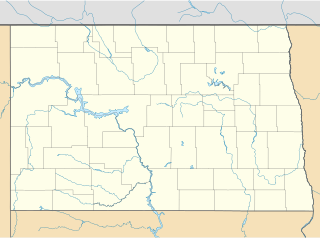
The Ladbury Church, near Dazey, North Dakota, was built in 1899 in Late Gothic Revival style. It was listed on the National Register of Historic Places in 2005. The listing included two contributing buildings and a contributing site on 4 acres (1.6 ha).
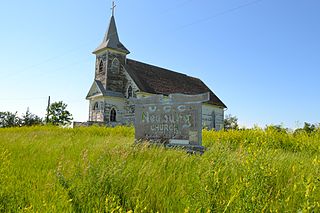
Neuburg Congregational Church near Mott, North Dakota was built in 1925. It has Gothic Revival architecture.
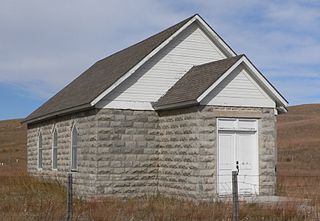
The Dry Valley Church and Cemetery, near Mullen, Nebraska, is a historic church that is listed on the National Register of Historic Places. The cemetery has about 80 graves.

Mount Vernon Springs Historic District is a national historic district located near Bonlee, Chatham County, North Carolina. The district encompasses 23 contributing buildings, 3 contributing sites, and 7 contributing structures in the rural village of Mount Vernon Springs. The village grew up near a locally famous mineral spring. Notable buildings include the Greek Revival style Female Dormitory of the Baptist Academy (1855), Gothic Revival style Mt. Vernon Springs Presbyterian Church (1885), the John C. Kirkman House, Robert P. Johnson House, and John M. Foust House. Also located in the district are the Mt. Vernon Springs, the Baptist Academy Cemetery, and the Mt. Vernon Springs Presbyterian Church cemetery.

Sharon Cemetery Historic District is located in rural Harrison Township, Lee County, Iowa, United States near the town of Farmington. It was listed on the National Register of Historic Places in 1991. At the time of its nomination the historic district included four contributing buildings, one contributing site, eight contributing structures, and one contributing object.

Sidney Historic District is a national historic district located at Sidney, Delaware County, New York. It encompasses 906 contributing buildings, 3 contributing sites, and 3 contributing structures in the northern half of the village of Sidney. The village developed after about 1771, and includes notable examples of Greek Revival, Gothic Revival, Italianate, Queen Anne, Colonial Revival, and Bungalow architecture. Located in the district is the separately listed Pioneer Cemetery. Other notable contributing resources are the Johnston-Clum House (1798), Spencer Block, Fairbanks Building, Elks Lodge #2175, Sidney High School (1929), municipal building (1909), Sidney Memorial Library, MacDonald Hose Company (1943), First Congregational Church (1808), United Methodist Church (1931), Smith-Cable house (1808), Ezra Clark house, and Prospect Hill Cemetery. The district also includes one especially well-documented multi-component archeological site representing the period 850 BC-1400 AD.

Bloomington West Side Historic District is a national historic district located at Bloomington, Monroe County, Indiana. The district encompasses 394 contributing buildings, 2 contributing sites, and 2 contributing structures in a mixed residential, commercial, and industrial section of Bloomington. It developed between about 1850 and 1946, and includes notable examples of Queen Anne and Bungalow/American Craftsman style architecture. Located in the district are the separately listed Elias Abel House, Cantol Wax Company Building, Coca-Cola Bottling Plant, Cochran-Helton-Lindley House, Illinois Central Railroad Freight Depot, Johnson's Creamery, and Second Baptist Church. Other notable contributing resources include the Works Progress Administration constructed wading pool, White Oak Cemetery, Ninth Street Park, Bloomington Wholesale Foods Warehouse, Bloomington Garage, Curry Buick, Banneker School, Bethel African Methodist Episcopal Church, and Bloomington Frosted Foods.

Central Cole Camp Historic District is a national historic district located at Cole Camp, Benton County, Missouri. The district encompasses 37 contributing buildings in the central business district of Cole Camp. It developed between about 1881 and 1951, and includes representative examples of period commercial, Romanesque Revival, and Italianate style architecture. Notable buildings include the Daisy Roller Mill, Citizens Bank (1898), Congregational Church (1913), Kroenke Dort Building, and Cole Camp Mercantile Building.

